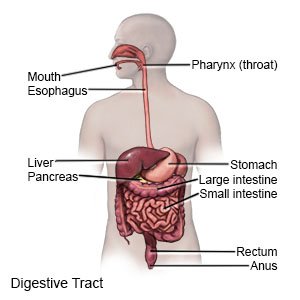Esophageal Varices
Medically reviewed by Drugs.com. Last updated on Aug 4, 2025.
Esophageal varices are swollen veins in the lower part of your esophagus. They are caused by increased pressure in the blood vessels of your liver. As the pressure builds in your liver, the pressure also builds in the veins in your esophagus.
 |
WHILE YOU ARE HERE:
Informed consent
is a legal document that explains the tests, treatments, or procedures that you may need. Informed consent means you understand what will be done and can make decisions about what you want. You give your permission when you sign the consent form. You can have someone sign this form for you if you are not able to sign it. You have the right to understand your medical care in words you know. Before you sign the consent form, understand the risks and benefits of what will be done. Make sure all your questions are answered.
An IV
is a small tube placed in your vein that is used to give you medicine or liquids.
A nasogastric (NG) tube
may be put into your nose, and passed down your throat until it reaches your stomach. The tube will be attached to a suction machine. If your varices are bleeding, the blood will go to your stomach. The suction machine will pull the blood from your stomach and your healthcare provider will be able to decide the best treatment for you.
Medicines:
- Antibiotics prevent or fight a bacterial infection.
- Beta-blockers decrease the pressure in your liver.
Related medications
Monitoring:
- Cardiac and oxygen monitoring is done to record the blood flow activity in your heart and measure the amount of oxygen in your blood. Decreased blood flow and oxygen levels may mean you have internal bleeding. A device is connected to your central line for this monitoring.
- Liver pressure monitoring is recorded through a small tube placed into a vein in your liver. Healthcare providers measure liver pressure. Your healthcare provider will know that your treatment is working if the pressure is lower.
Tests:
- Blood tests are used to check for an infection, or if your body is responding to treatment.
- An x-ray is used to see if you have blood or an infection in your lungs.
- An EGD uses an endoscope to see the walls of your esophagus and upper intestines. An endoscope is a bendable metal tube with a light and tiny camera on the end. It is placed down your throat and guided into your stomach and intestines. Your healthcare provider will be able to see where you are bleeding. This may be repeated while you are in the hospital.
- An MRI may show a break in your varices. You may be given contrast liquid to help the varices show up better. Tell your healthcare provider if you have ever had an allergic reaction to contrast liquid. Do not enter the MRI room with anything metal. Metal can cause serious injury. Tell your healthcare provider if you have any metal in or on your body.
- A barium swallow is an x-ray of your throat and esophagus. It may also be called a barium esophagram. You will drink a thick liquid called barium. Barium helps your esophagus and stomach show up better on x-rays. A barium swallow can help your healthcare provider find where you are bleeding.
Treatment:
- Balloon tamponade is a procedure used to control bleeding. A balloon is placed in the esophagus and inflated. The balloon puts pressure on the varices to control bleeding. This allows your healthcare provider to decide what treatment is best for you. The balloon is not permanent.
- Endoscopic variceal band ligation is done to slow down or stop the bleeding. Bands are placed around the large varices in your esophagus. The pressure of the bands causes the varices to shrink.
- Endoscopic sclerotherapy uses medicine in the varices to make them smaller and stop the bleeding.
- Surgery may be needed to control the bleeding. A shunt may be placed in a vein in your liver. The shunt is connected to a larger vein. This will lower the pressure in the veins in your liver. Surgery may also be needed to remove the part of your esophagus that is bleeding. This is done to control severe bleeding.
- A blood transfusion may be needed if you lose too much blood from burst varices. You may get whole or parts of blood, such as platelets or plasma, through an IV.
Treatment options
The following list of medications are related to or used in the treatment of this condition.
RISKS:
You may have severe abdominal pain or see blood in your vomit or bowel movements if your varices bleed. Bleeding can also cause confusion, chest pain, and shortness of breath. You may need a blood transfusion if you lose too much blood. Blood loss can be life-threatening. You may need a liver transplant if your liver fails.
CARE AGREEMENT:
You have the right to help plan your care. Learn about your health condition and how it may be treated. Discuss treatment options with your healthcare providers to decide what care you want to receive. You always have the right to refuse treatment.© Copyright Merative 2025 Information is for End User's use only and may not be sold, redistributed or otherwise used for commercial purposes.
The above information is an educational aid only. It is not intended as medical advice for individual conditions or treatments. Talk to your doctor, nurse or pharmacist before following any medical regimen to see if it is safe and effective for you.
Learn more about Esophageal Varices
Treatment options
Care guides
Symptoms and treatments
Further information
Always consult your healthcare provider to ensure the information displayed on this page applies to your personal circumstances.
